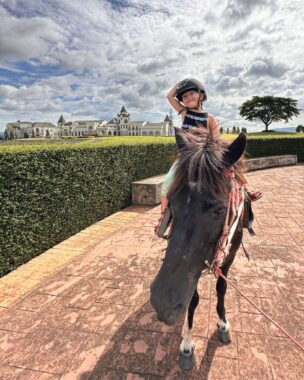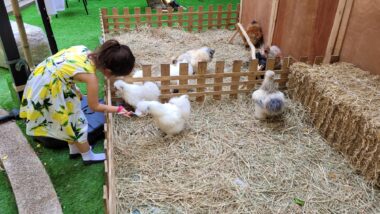The benefits of animal therapy for our daughter with AADC deficiency
Visiting animal farms and riding horses is a favorite activity for this family

While holding my daughter Rylae-Ann’s hands like a puppeteer, I allowed her fingers to touch the wet snout of a horse. She let out a giggle. That was the moment her love for animals began.
After we learned that Rylae-Ann has a rare neurotransmitter disease known as aromatic l-amino acid decarboxylase (AADC) deficiency, we began a steady routine of therapies. It took time to build this routine; initially, it was all tears. Even before entering a clinic, Rylae-Ann would scream, which continued for most, if not all, of the session.
But with equine-assisted therapy, she cried when she had to leave. She was excited to ride horses and continues to ride regularly.
The sessions began with brushing the horse and ended with a feeding. My wife and I saw this as a perfect opportunity to teach occupational therapy skills. But if we added more lessons, it would be pretty costly. A workaround we found was petting zoos and farms.

Rylae-Ann finishes a horse ride at a large farm in Thailand, earlier this year. (Photo by Richard E. Poulin III)
Visits to the farm
Visiting the farm was often free. Spending time outdoors allowed us all to get rid of built-up stress. Being with different animals gave Rylae-Ann a childhood experience I had always wanted for her.
There was an apparent unspoken connection with each animal she touched or fed. As educators, my wife and I both knew that animal therapy supports children with special needs and disabilities, but it was amazing to see it happen firsthand.
While at the farm, we could also pick up fresh vegetables, fruits, meat, and eggs to maintain her healthy diet. If we weren’t with the animals, we were using the opportunity to practice walking and other skills.

Rylae-Ann practices using a spoon while feeding chickens at a petting zoo in Thailand, earlier this year. (Photo by Richard E. Poulin III)
Favorite animals
The sheep and goats at the farm were fun and always enthusiastic about a handout. However, they can be more aggressive. Even when calm, these bubbly creatures can easily knock over our daughter due to their eagerness for a carrot.
Rylae-Ann didn’t seem scared, but we were. We generally skipped walking in those pens. Our favorite animals were the cows and pigs.
Despite their large size, the cows are always gentle around our daughter. It’s like they have a sixth sense about how to interact with her. Even the calves were careful not to knock over our daughter as they guzzled down milk from a bottle she fed to them.
I didn’t think Rylae-Ann would like pigs because she hates getting dirty, but she yelled for them as soon as we arrived. Maybe it’s the cute grunts or the wiggle of their bottoms, but she giggled nonstop while at their pens. The sounds of her happiness were so infectious that my wife and I recorded her laughter and used it as a ringtone for a while.
We continue to make horse riding, farms, and petting zoos part of our lives. Each destination lets Rylae-Ann get close to and connect with the animals. We use these interactions as an opportunity to achieve various therapy goals.

Rylae-Ann uses her strength to lift a heavy milk bottle to feed calves at a farm in Thailand, earlier this year. (Photo by Richard E. Poulin III)
Note: AADC News is strictly a news and information website about the disease. It does not provide medical advice, diagnosis, or treatment. This content is not intended to be a substitute for professional medical advice, diagnosis, or treatment. Always seek the advice of your physician or other qualified health provider with any questions you may have regarding a medical condition. Never disregard professional medical advice or delay in seeking it because of something you have read on this website. The opinions expressed in this column are not those of AADC News or its parent company, BioNews, and are intended to spark discussion about issues pertaining to aromatic l-amino acid decarboxylase deficiency.






Comments